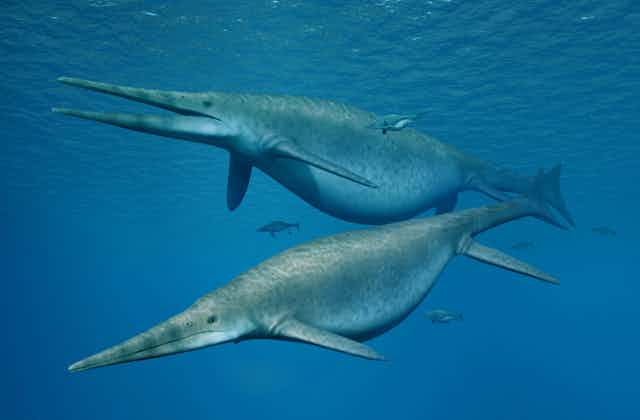When fossil collector Paul De la Salle discovered pieces of a giant bone on Lilstock beach in Somerset in May 2016, he didn’t realise he had stumbled on a clue to a near 170-year-old mystery. Returning to the beach the following month, he found more pieces that together measured about a metre in length. De la Salle realised he was looking at the lower jaw of a huge ichthyosaur, an ancient type of marine reptile that lived at the same time as the dinosaurs.
De la Salle then contacted me, Judy Massare from the State University of New York and professional geologist Ramues Gallois. To say we were very excited would be an understatement. The specimen, which we describe in a new paper in PLOS ONE, was around 205m-years-old, dating from the late Triassic period.
Massare and I agreed the fossil was an incomplete “surangular” bone from the lower jaw of a giant ichthyosaur because it had several notable features such as a prominent groove in the surface facing towards the middle of the body. We were also surprised to discover there were very few detailed descriptions of ichthyosaur surangular bones in the academic literature, and even less information on giant specimens.
We eventually realised the Lilstock ichthyosaur was so big it could be the largest of its kind ever discovered, comparable to a blue whale in length. What’s more, the new specimen helped us demonstrate that several other large fossil bones discovered in 1850 were also from giant ichthyosaurs and not huge land reptiles as previously thought.

To reach this conclusion, Massare and I visited the Royal Tyrrell Museum of Palaeontology in Alberta, Canada. There we compared the Lilstock specimen with the largest known ichthyosaur, the giant Shonisaurus sikanniensis, which has a total length of 21 metres. The similarities between its surangular and our specimen suggest the Lilstock creature was from the same shastasaurid family of ichthyosaurs.
It’s very difficult to accurately estimate the animal’s size because we only have a large piece of its jaw. But we do know that the Lilstock fossil is about 25% larger than the same bone in S. sikanniensis. So using a simple scaling factor, we can estimate that our ichthyosaur was up to 26m long. Comparing it with other shastasaurid ichthyosaurs suggests that it was between 20 metres and 25 metres in length.
The differences between species and individuals means we can’t be sure about these figures. But this kind of simple scaling is a common way of estimating size in palaeontology, especially when there aren’t many samples to compare.

A mystery solved?
Our new study also provides new evidence for the origin of five other incomplete bones from the Late Triassic found up the coast from Lilstock at Aust Cliff in Gloucestershire in 1850, two of which are now missing and presumed destroyed. Although other ichthyosaur vertebrae have also been found in the area, these Victorian discoveries were previously described as the limb bones of early dinosaurs (notably stegosaurs or sauropods) or indeterminate land reptiles.
But comparing them with the Lilstock specimen suggests they are actually jaw fragments of giant, previously unrecognised ichthyosaurs. One or two of the fossils are probably also surangulars but they might be other types of jaw bone. They might even by parts of a giant hyoid (the U-shaped bone that supports the tongue), as the same bone in S. sikanniensis is similarly large.
Given the changing opinions about these bones, which have generally been considered to come from dinosaurs, I suspect that our study will generate even more interest in these fossils. And hopefully more existing specimens in museum and private collections that are currently thought to be dinosaur bones will be correctly re-identified as coming from ichthyosaur.

